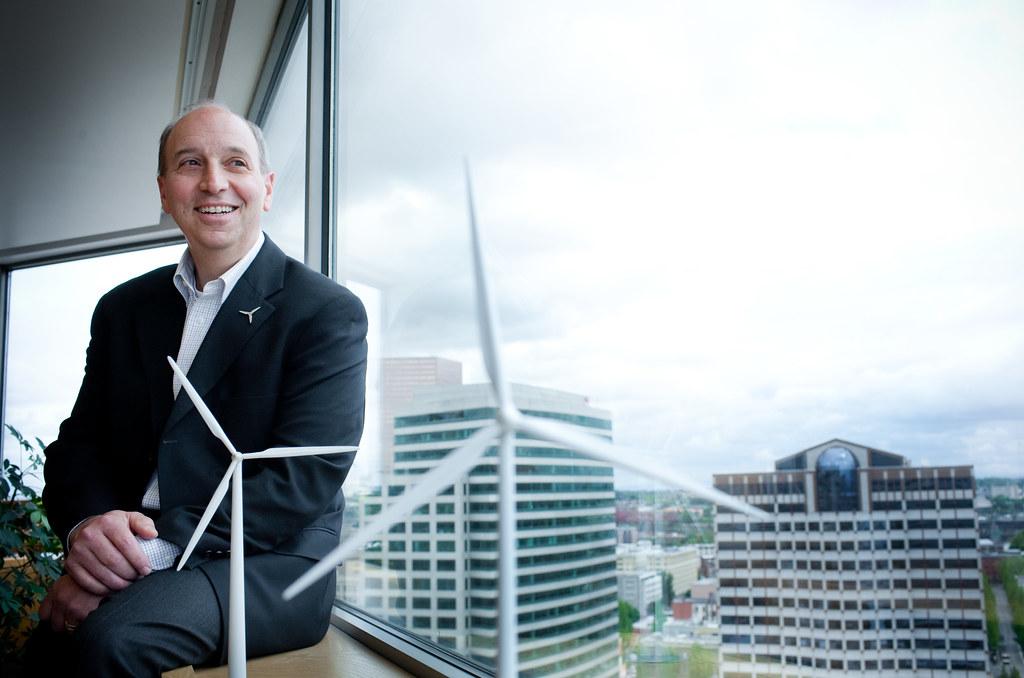
Image: Jim Piro, retired CEO of the investor-owned utility company Portland General Electric.
The transition to zero-emission vehicles is unfolding before our eyes. “We are at an exciting point where more and more electric vehicles with longer ranges are coming out,” said Jim Piro, retired CEO of Portland General Electric (PGE), an investor-owned utility company based in Portland, Oregon. “We are at that critical junction. I want us to take a big step forward and have electric vehicles be the attractive choice for consumers. ”
There is no one clear path, however, for the best way to make it happen. As co-convener of the governor’s sponsored Oregon Electric Vehicle Collaborative project, Piro is dedicated to developing solutions that chart the way forward. Oregon has committed to put 50,000 registered electric vehicles on the roads by 2020. The ultimate goal is for all passenger vehicle sales in Oregon to be Zero Emission Vehicles no later than 2050.
TriplePundit recently sat down with Piro, and he offered a multi-faceted perspective on the future of electric mobility based on his 43-year career in the electric industry. He has received national recognition for leading PGE in the development of renewable energy and electric transportation and pioneered the implementation of clean technologies in Oregon. Read on for his top insights.
TriplePundit: Why do you believe vehicle electrification is important?
Jim Piro: Vehicle electrification can address climate change while at the same time promote innovation and improve a city’s overall atmosphere and environment. For the electric utility, electric vehicles can help facilitate an efficient electricity system and not only grow load in a time of more energy efficiency, but also help manage load.
With more renewable energy penetration across the country, we need loads that are more flexible. Electric vehicles can be a storage device when there is excess renewable energy. Down the road, they can be a vehicle-to-grid and vehicle-to-home resource, too.
As CEO I believed you either, “lead, follow or get out of the way.” As an organization, the more I encouraged employees to lead and think outside the box, the more we identified opportunities to innovate and grow. The more we work together on improving the overall environment for electric vehicles, the better chance this market will grow.
TriplePundit: What do you see as ways to promote EV adoption?
JP: Economics, infrastructure and education matter. We need to help the car manufacturers sell cars. Initially, we need smart incentives to create a strong charging infrastructure and we need to tell the story about the benefit of EVs to a whole range of customers. Ultimately, we have to make it easy for consumers to purchase EVs and charge them.
Educating people on electricity as a transportation fuel and its full value is important. People understand price per gallon, but they don’t understand the idea that 12 cents per kilowatt-hour is about $1 per gallon. Moreover, electricity prices are much less volatile than gasoline and will be even more so as we reduce our dependence on fossil fuels.
Helping people understand that the technology is ready is vital, too. More cars are coming out with enough range, prices are coming down, and reliability is good. I think the cars are outstanding, and telling that story is central. I have driven my Chevy Volt over 70,000 miles, and I have only used 400 gallons of gas.
TriplePundit: Can you tell us about Oregon’s goals for clean transportation?
JP: Oregon set a goal of 50,000 electric vehicles by 2020. But I would look at that as just an interim goal. The idea is: How do we catapult Oregon on a trajectory to a much deeper penetration of electric vehicles? I am one of three co-conveners leading the Oregon Electric Vehicle Collaborative, an Oregon Solutions project supported by the governor. We are bringing key stakeholders together to explore what we can do collectively with the tools we have today to increase electric vehicle sales as opposed to waiting for the legislature to implement additional policy changes.
TriplePundit: What is the process for the Oregon Electric Vehicle Collaborative?
JP: We will look at the things that stakeholders have some jurisdiction over for promoting electric vehicles and explore how to make it attractive for consumers to buy electric vehicles. We intend to evaluate a whole suite of ideas, such as consumer education, charging infrastructure, incentives, regulations and policies (like giving electric vehicles access to HOV/carpool lanes). It is a six-month process that has just begun. I am optimistic; we will have to see where it takes us.
TriplePundit: Is the Collaborative addressing equitable access to clean transportation?
JP: One of the charters of Oregon Solutions is to look at electrification from an equity perspective. Most low-income people do not have access to charging and often live in multifamily homes. We expect to examine solutions such as common-area charging pods, ride-share programs, lease programs, and second-use leases of less expensive electric vehicles.
TriplePundit: Are some countries already doing vehicle electrification right?
JP: Norway has an effective mix. They have given a number of attractive incentives, such as no sales tax on zero-emissions vehicles, free tolls and bridge crossing, and access to HOV lanes. The country is providing charging infrastructure, and in some cases the charging is free. With this confluence of opportunity, they have reached 58 percent of new car sales being electric. China is also heavily promoting electric transportation. We should also look at what they are doing.
TriplePundit: Why would a person or business want to invest in an electric vehicle?
JP: Price and convenience are big reasons. You can run your car for $1 per gallon equivalent or less and charge onsite. You just need to plug your vehicle in, and the fuel is always there. A lot of that $1 comes from peak load prices. If you can incent people to charge off-peak, you could charge the marginal cost of energy—which can be close to zero in a more renewable energy environment.
TriplePundit: How do we encourage business investment in electric transportation?
JP: We need pilot projects and the development of playbooks to help make businesses more confident. In Oregon, PGE is currently working with TriMet on an exciting all-electric bus pilot.
If you have a pilot project, you can build a playbook based on things like weight, distance traveled and the cost of charging infrastructure. This would be especially useful for buses and delivery trucks. There are also benefits to consider such as the environmental impact and a better driving experience. Electric buses and delivery trucks remove idling fumes and are smooth to operate.
TriplePundit: Do you see the utility as having a role with electric vehicle infrastructure?
JP: I believe a good example for how a utility could manage a charging infrastructure is similar to how utilities generally manages street lights. In some cases, a utility owns that infrastructure and provide that service to customers. In other cases, the utility would bring that service to whoever owns and is managing that charger.
Finding advantageous pricing and economic signals is important so that people charge at the right time. We desperately need to ensure that on-peak charging doesn’t happen unless necessary, because that is going to put extra load on the system and extra cost. We want vehicles and chargers to be smart enough to take a signal to say, “I don’t need to charge right now. It is too expensive. I will charge later.”
Also important is that the power is safe, reliable and secure. Utilities are concerned that the chargers are maintained and safe. Electricity is a dangerous product, and chargers can become a danger to the public if not properly maintained.
TriplePundit: How do states meet their clean transportation goals?
JP: As a state, you have to look at the whole basket of things. Having transportation incentives and developing charging infrastructure is important. Oregon is looking at cap and trade, but I also like the idea of state mandates. Clear direction allows companies to plan for the future. While the market mechanisms can create price signals, I tend to prefer being given a target to hit as opposed to driving to it with an uncertain economic incentive.
TriplePundit: Do you have examples of successful mandates and initiatives?
JP: Mandates can be helpful because they provide long-term stability and predictability. In Oregon, utilities built low-cost hydroelectric facilities with long-term investment. If there hadn’t been an assured recovery of costs on prudent investments, then it would have been harder to make those investments.
Utilities in Oregon have been successfully transitioning their electricity generation fleets from coal and natural gas to renewables because of state mandates. We had mandates to phase out coal generation for electricity in Oregon by 2035 and a renewable portfolio standard (RPS) of 50 percent by 2040. With hydroelectricity, Oregon’s electricity will be 90 percent clean. As an initiative, PGE is also shutting its Boardman coal plant down in 2020. This decision was a result of a very successful collaborative process with key stakeholders that I am very proud of.
TriplePundit: How do you sum up the work to be done in Oregon and worldwide when it comes to vehicle electrification?
JP: Oregon is currently a leader in electric mobility. In Oregon, we think and plan long-term and work collaboratively together. We don’t have to get it all done today, but we are good at developing executable plans to reach our goals.
If we think and plan long-term, we will develop more robust and sustainable solutions. Ultimately, we need to tell the story about the benefit of electric vehicles and make it easy for consumers to purchase EVs and charge them. If we agree as a community that this is where we want to go, then we can find a way to get there.
Image courtesy of Jim Piro and PGE

Leah Y Parks is co-author of the book, "All-Electric America: A Climate Solution and the Hopeful Future." She is former editor for ElectricityPolicy.com and Electricity Daily, a journal that informed utility executives and commissioners about the current events and the state of the electricity industry. Parks is currently a freelance writer and VP of Business Development at OpConnect, an electric vehicle fueling solution provider.














